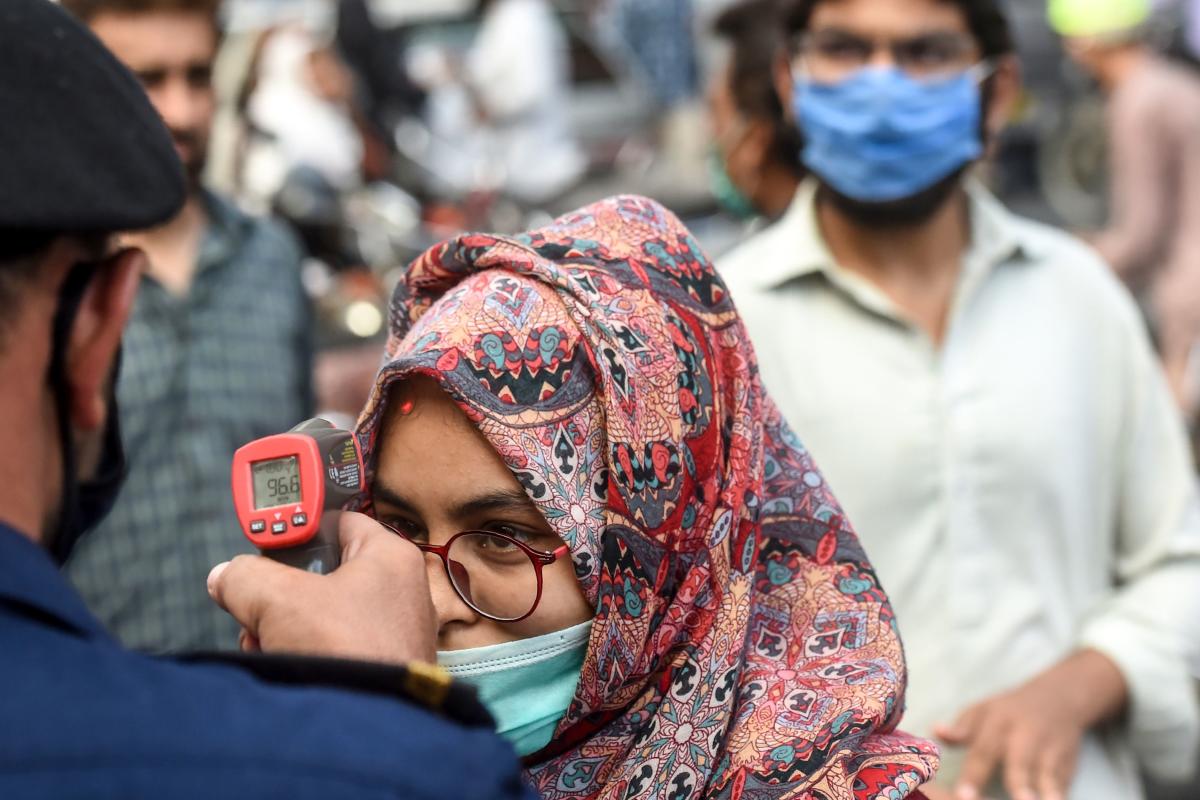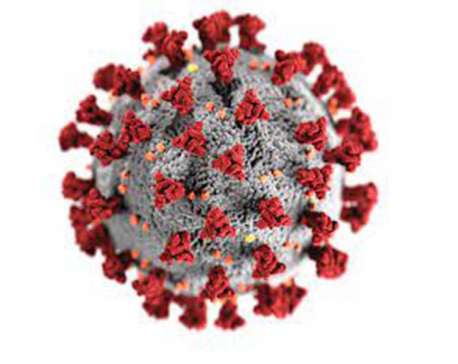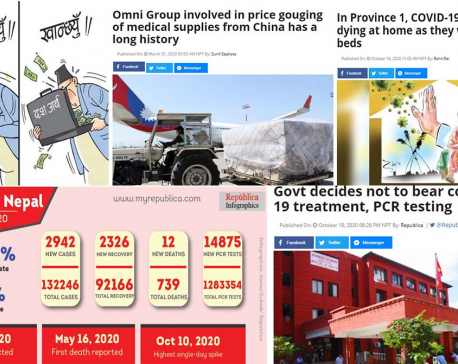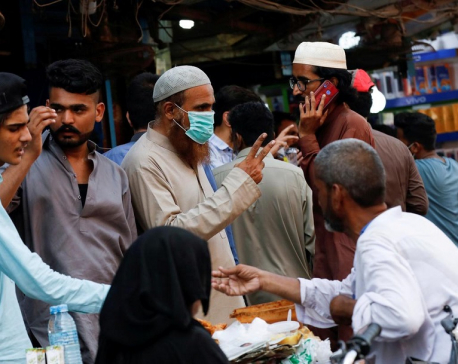
OR
Pakistan’s Covid-19 coping strategies: Can Nepal follow?
Published On: December 8, 2020 08:15 AM NPT By: Dr Imran Ur Rahman


Dr Imran Ur Rahman
Dr Imran Ur Rahman is Associate Professor at Leshan Normal University and Senior Research Fellow at Center for Trans-Himalaya Studies, Sichuan, China.news@myrepublica.com
More from Author
Like Pakistan, Nepal also has a huge portion of youth population who can be employed to raise awareness about the Covid-19 and provide community relief.
Pakistan is one of the few nations which has been able to control the first wave of COVID-19 and flatten the curve while keeping the economy open for small businesses and workers. At a time when the other countries were reporting increased cases of COVID-19, Pakistan was keeping the virus at bay. Under the leadership of Prime Minister Imran Khan, with timely and innovative policies, the country managed to overcome the first wave of COVID-19 with minimum economic losses. According to WHO, Pakistan had come up with the one of world’s best “national response programs’’ against COVID-19 pandemic.
Since the inception of 2020, the entire world has been affected by the outbreak of COVID-19. Different measures and policies are adopted by governments to control and contain the outbreak.
As a result, nations around the world are encountering socio-economic and geo-political challenges. Some countries like China and New Zealand are able to control the outbreak while other nations like the US and India have not been successful enough.
Both developing and developed nations around the globe are also facing the possibility of a second wave of the outbreak after the first wave curve is flattened. Such scenario poses huge threats and risks especially for middle, lower middle and poor nations across the world.
Unlike their developed counterparts, most of the developing nations do not possess enough resources and finances to tackle a prolonged impact of the epidemic.
Pakistan faced similar risks of economic fallout, financial recession, unprecedented unemployment, spiked inflation and worsening of the poverty level in the country. At the government level, civil unrest and political destabilization were main concerns, which would have further deteriorated the economy.
Like other nations, Pakistan also experienced spike in new cases of COVID-19 during the months of March and April. Prime Minister Imran Khan unwillingly put measures of strict lockdown of cities, businesses and schools throughout the country. The services of law enforcement agencies were also acquired to ensure the citizens strictly follow the lockdown measures put in place by the government.
Then Imran Khan lifted the measures given the fact that the poorest people were suffering the most. During his address to the nation PM said: “If the government continued the lockdown, more people will die of hunger and poverty than deaths from COVID-19”. The PM further reiterated that “25 percent of Pakistanis are below the poverty line. They can’t even afford two square meals a day. If working class Pakistanis are locked up for two weeks, how will they feed their families?”
Soon after, the government put forth the COVID-19 control plan at national level that included three major aspects of smart lockdown approach, employment and business opportunities for the poor and utilization of youth by creating a Tiger Force.
The first wave of COVID-19 in Pakistan reached its peak by July 14, 2020, reporting 6285 cases in a single day which was very low compared to neighboring India. With government efforts, by August 4, 2020, the cases in Pakistan declined to the minimum level.
These efforts of the government of Pakistan to control the spread of the virus were recognized and appreciated by different world leaders and organizations. Leaders of China, the US, the UK, Germany, Japan, United Nations and WHO praised the government of Pakistan for combating the outbreak while keeping the economy open.
What Pakistan did
Following the approach used by China, PM Khan introduced the concept of “smart lockdown” policy in targeted areas which were the hotspots of new cases of COVID-19. Unlike China, Pakistan could not afford complete lockdown for a prolonged period due to financial constraints.
Therefore, it was necessary to devise a policy that would prevent the spread of the virus and at the same time enable workers and small businesses to operate safely.
The smart lockdowns were implemented within the outbreak hotspots throughout the country while other areas remained open for usual businesses and economic activities. As a result, most of the poor households especially laborers and daily wage workers were able to continue earning their livelihoods.
In addition, both at the central and local levels, the provision of subsidies and the distribution of food products to the poorest were also ensured. In order to provide a chance for poor households to earn some money to feed their families, the project of planting trees for a particular amount of cash per plant was also initiated.
Pakistan, with financial shortage, had to establish a plan to overcome the consequences of the epidemic. For that the government tapped into the most abundant resource in the country—the youth—which account for nearly seventy percent of the country’s population.
The Corona Relief Tiger Force (CTRF) was created to employ the youth as volunteers for creating awareness among the public and dissemination of information relevant to COVID-19 prevention. The Tiger Force volunteers also participated in provision of essential support to the federal and local authorities in controlling the outbreak and providing relief to the public.
According to Usman Dar, Special Assistant to the Prime Minister on Youth Affairs, “more than 1 million individuals signed up for the Tiger Force. Among the more than million who signed up for the Tigers force, some 400,000 are students, including 50,000 engineers, 45,000 teachers, and around 6,000 lawyers”.
CTRF volunteers were successful in raising awareness among the public, checking market prices of essential items, provision of relief to the poor and implementing social distancing measures.
Vital industries and businesses have reopened in the country and life has gradually returned to normalcy. But the epidemic is far from over as the country is experiencing a second wave of the outbreak.
Although, the economy seems to be progressing and economic indicators show positive figures, the government needs to be efficient given the devastating effects of COVID-19. Unlike developed nations, Pakistan would not be able to afford another severe wave of the outbreak. The government needs to keep a vigilant eye on new cases and expand testing facilities to different hospitals and medical centers in the country. It is also necessary to keep the economy going forward and to take steps to protect the livelihoods of marginalized communities. Proactive lockdown policies of the government and active role of the Tiger Force will determine the magnitude of the second wave in the upcoming months.
Nepal may follow
The policies implemented by the government of Pakistan also have implications for other developing nations with similar socio-economic conditions. For instance, unlike high income nations, Nepal does not have adequate financial and economic capital to cope with the implications of COVID-19 as a developing country. Long-term lockdowns can prove detrimental to the economy and the communities. In targeted hotspots, the short-term and smart lock-down approach could be more fruitful as it will allow economic activities and income flows for poor households in the unaffected areas.
Moreover, Nepal's health system is not equipped with new technology and tools, which create barriers to the monitoring and containment of the outbreak. Fortunately, like Pakistan, Nepal also has a huge portion of youth population who can be employed to raise awareness and provide community relief.
Sixty five percent of Nepali population falls under 15-64 years age group, which means that this group of people can be instrumental in helping the country to combat the virus. Organizing and educating these resourceful young people to disseminate information and resolve emergency situations under COVID-19 will enable the government to control the outbreak and effectively recover the economy.
You May Like This

Pakistan adds 6,540 new COVID-19 cases, 12 more deaths
ISLAMABAD, Jan 22: Pakistan added 6,540 new COVID-19 cases over the past 24 hours, the National Command and Operation Center... Read More...

As Oli government limits its role to counting deaths during the greatest public health crisis, people are dying at an alarming rate
Experts say the government has decided to shred the constitution ... Read More...

Pakistan cracks down on safety breaches, coronavirus cases top 100,000
ISLAMABAD, June 8: Pakistan has recorded more than 100,000 coronavirus infections, officials statistics showed on Monday and the rise in... Read More...

Just In
- World Malaria Day: Foreign returnees more susceptible to the vector-borne disease
- MoEST seeks EC’s help in identifying teachers linked to political parties
- 70 community and national forests affected by fire in Parbat till Wednesday
- NEPSE loses 3.24 points, while daily turnover inclines to Rs 2.36 billion
- Pak Embassy awards scholarships to 180 Nepali students
- President Paudel approves mobilization of army personnel for by-elections security
- Bhajang and Ilam by-elections: 69 polling stations classified as ‘highly sensitive’
- Karnali CM Kandel secures vote of confidence


















Leave A Comment